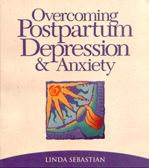Postpartum Anxiety Disorders
Postpartum anxiety disorders in new mothers are often missed. Read why. Also symtoms, strategies for managing postpartum anxiety.
Overcoming Postpartum Depression and Anxiety
To understand the various kinds of anxiety disorders that may accompany pregnancy and the postpartum period, it is helpful for you to first understand the kind of anxiety that nearly everyone experiences. People with anxiety disorders often report that others minimize, or brush off, their problems. This may occur because all people experience anxiety. Most people do not understand the difference between anxiety disorders and normal anxiety.
 Anxiety is a part of our lives. It is a normal and protective response to events outside the range of everyday human experience. It helps us concentrate and focus on tasks. It helps us avoid dangerous situations. Anxiety also provides motivation to accomplish things that we may otherwise tend to put off. As you can see, anxiety is essential to our survival.
Anxiety is a part of our lives. It is a normal and protective response to events outside the range of everyday human experience. It helps us concentrate and focus on tasks. It helps us avoid dangerous situations. Anxiety also provides motivation to accomplish things that we may otherwise tend to put off. As you can see, anxiety is essential to our survival.
Anxiety is often described as a spectrum of feelings. Just about everyone experiences mild or moderate anxiety as we go about our work and play. When we have moderate anxiety, our heart rates increase minimally so that there is more oxygen available. We are alert so we can focus better on a task or problem. Our muscles are slightly tensed so we can move and work. Our production of hormones, such as adrenaline and insulin, is slightly elevated to help the body react. We can study for a test, prepare a report for work, give a speech, or hit the ball when we are up to bat. If we were completely relaxed, we could not concentrate or accomplish these tasks. Anxiety helps us meet the demands made on us.
relaxed/calm -- mild -- moderate -- severe -- panic
The subjective feeling we call anxiety is accompanied by a predictable pattern of bodily responses summarized in the continuum above. People with anxiety disorders have reactions, designed to help us escape danger, in situations that are not life threatening. The normal mechanism for initiating these responses goes awry for reasons we do not fully understand. When we have severe anxiety, we do not think well and cannot solve problems. Production of adrenaline is so high that it causes a sensation of a "pounding" heart, shortness of breath, and extremely tense muscles. We feel a sense of danger or dread. This fear may or may not have a focus. If we were facing a tiger, this level of anxiety would be helpful to us to fight or flee. However, if this level of anxiety occurs without a dangerous stimulus, this response is not helpful. Anxiety disorders differ from anxiety in general in that the experience or feelings are more intense and last longer. Anxiety disorders also interfere with the normal functioning of people at work, at play, and in relationships.
When we are faced with real or imagined threats, our brain signals the body that we are in danger. Hormones are released as part of this general alarm call. These hormones produce the following changes:
- the mind is more alert
- blood clotting ability increases, preparing for injury
- heart rate increases and blood pressure rises (there may be a sensation of the heart pounding and a tightness in the chest)
- sweating increases to help cool the body
- blood is diverted to the muscles to help prepare for action (this may lead to a light-headed feeling as well as a tingling in the hands)
- digestion slows down (this may lead to a heavy feeling like a "lump" in the stomach, as well as nausea)
- saliva production decreases (which leads to a dry mouth and a choking sensation)
- breathing rate increases (which may feel like shortness of breath)
- liver releases sugar to provide quick energy (which may feel like a "rush")
- sphincter muscles contract to close the opening of the bowel and bladder
- immune response decreases (useful in the short term to let the body respond to a threat, but over time harmful to our health)
- thinking speeds up
- there is a sensation of fear, a desire to move or take action, and an inability to sit still
Is Anxiety Normal for New Mothers?
All new mothers are somewhat anxious. Being a mother is a new role, a new job, with a new person in your life and new, responsibilities. Anxiety in response to this situation is very common. Pediatricians, obstetricians, and nurses are used to worries, concerns, and questions like yours.
However, for reasons we cannot explain, some mothers have excessive worries and experience a severe level of anxiety. Dori, a new mother, describes her anxiety:
I could not sit still or relax at all. My thoughts were racing, and I couldn't focus on anything at all. I worried constantly that something was wrong with the baby or that I would do something wrong. I had never felt this kind of anxiety before, but I didn't know if it was normal for new mothers.
As with Dori, mothers with severe anxiety have difficulty enjoying their new babies, and they are overly concerned about minor problems. They have unrealistic fears about doing something wrong to hurt the baby. Mothers with severe anxiety cannot relax when there is an opportunity to do so. Anxiety disorders are often missed in new mothers because of the belief that all new mothers are excessively anxious. If you find yourself meeting the criteria for any of the anxiety disorders described in this chapter, or if you are very uncomfortable for prolonged periods such as several hours, talk to your health care provider. Take this book with you and share your concerns, because not all health care providers are familiar with the criteria for anxiety disorders.
Why Anxiety Disorders and Panic for Some?
Although anxiety is a normal human response to stress, we are not sure why some people have severe anxiety or panic in response to everyday situations. As with depression, there are several theories about why these problems occur.
One theory proposes that some people have a biological tendency toward anxiety. Some people seem to be more sensitive to the effects of the hormones released during anxiety. There may be a genetic link in some disorders. Because the chemicals in the brain that are affected in anxiety are similar to the ones affected during depression, family history is important in determining what kind of disorder is present and what kind of treatment may help.
Another theory proposes that anxiety is a learned response to negative or fearful situations as we grow up. If you were around someone who was fearful, negative, and/or critical when you were a child, you may have developed a long-standing habit of assuming the worst is going to happen or reacting negatively to events. This theory also explains why trauma, an extremely upsetting event, may play a role in the development of anxiety. If you are in an accident, if you see someone die, or if you are attacked, you may have a reaction that marks the beginning of an anxiety disorder. Reactions to stress and loss may also be a factor.
There is probably no one single reason why people develop anxiety disorders. Because we are limited in our understanding of how these disorders develop, it is probably not all that helpful to try to figure out how yours started or which family member "gave" you this problem. You will find it more productive to look at how you can respond differently to situations that make you anxious, to modify the physiological response to these situations, and to master your habit of negative thinking.
People with anxiety disorders are often known as "worriers" concerned about control and perfectionism. These can be good traits to have. But when the need for perfectionism or control interferes with your life, an anxiety disorder often develops.
If you find yourself fitting the criteria for a diagnosis of an anxiety disorder, it is important that the possible physical causes of these symptoms be eliminated. Several physical illnesses may cause symptoms similar to these disorders. A basic principle of mental health treatment is to first rule out any physical causes of symptoms. Some of these physical conditions or illnesses are hypoglycemia (low blood sugar), hyperthyroidism (an overactive thyroid), inner ear problems, mitral valve prolapse, hypertension, and some nutritional deficiencies. While the anxiety symptoms caused by these problems affect only a small percentage of people with the symptoms, it is important to first investigate all the possible causes of the symptoms.
What Anxiety Disorders are Common in the Postpartum Period?
Women with postpartum anxiety disorders experience a spectrum of problems that range in severity from adjustment disorder to generalized anxiety disorder (GAD) to obsessive-compulsive disorder to panic disorder. In this chapter, we'll review the symptoms of each disorder, according to the American Psychological Association's Diagnostic and Statistical Manual of Mental Disorders.
It's important to note, however, that these anxiety disorders are not unique to the postpartum period. In fact, anxiety disorders are one of the most common psychiatric problems seen by mental health and family practice professionals. Studies show that more women than men suffer anxiety disorders. About 10 percent of women in the United States will have an anxiety disorder sometime in their lives, while 5 percent of men will experience these problems.
Adjustment disorder is a reaction to an external stress beyond what is considered typical. It is usually time-limited and responds well to minimal intervention. Many people have difficulty accommodating to changes in their lives such as divorce, job loss, retirement, or other crises.
Twenty-nine-year-old Darla's story is typical of a problem called adjustment disorder. Although it is not specifically an anxiety disorder, adjustment disorder is included in this section because anxiety is such a common feature. However, symptoms of depression may be present also.
After my son was born, I felt "revved up" and could not sit down and relax for a minute. I felt like there was a motor inside that would not shut off. I just thought it was the excitement of having the baby we had wanted for so long. When I got home from the hospital, I couldn't sleep at all. I got so tired and irritable that when he cried I wanted to yell, "Shut up!" This only made me feel worse. I was worried I was not going to be able to handle being a mother. I found myself avoiding taking care of my baby. It took me almost two weeks before I could enjoy him.
Darla was referred to a therapist who helped her learn to relax and to not worry so much about minor problems like diaper rash. Darla tended to "catastrophize." Small events took on life-and-death proportions in her thinking. Darla learned to observe herself catastrophizing and to be more objective in her assessment of situations. After several sessions with the therapist, Darla was less anxious, was beginning to enjoy the baby, and was able to sleep when the baby slept.
Are You Having Any of These Symptoms?
- Are you so anxious that you cannot adquately care for your baby?
- Are you afraid of hurting yourself or the baby to the extent that you are not sure that you can stop yourself?
- Are your compulsive behaviors harmful to the baby?
- Are you so anxious that you cannot eat or sleep?
If so, consult a mental health professional and tell him/her that you require immediate attention.
Symptoms of Adjustment Disorder
- Emotional or behavioral symptoms develop in response to identifiable stressor(s), occurring within three months of the onset of the stressor(s).
- These symptoms or behaviors are shown by either marked distress in excess of what would normally be expected from exposure to the stressor or by significant impairment in social or occupational functions.
- The symptoms are not related to bereavement or grief.
- The symptoms last no more than six months once the stressor has stopped.
What Is Generalized Anxiety Disorder?
A more severe form of anxiety is generalized anxiety disorder (GAD). This illness is characterized by a persistent anxiety that affects most areas of a person's life. This disorder is accompanied by worries or fears that are out of proportion to the situation. Many people, men and women alike, have this kind of anxiety but never seek treatment. They are known to their friends and families as "worriers."
If a woman with GAD becomes pregnant, she may feel less anxiety during her pregnancy. But she is likely to experience anxiety again after delivery. Since anxiety continues during pregnancy for some women, it is difficult to predict who will experience anxiety during pregnancy. Jill's story is very typical of a new mother with GAD:
I have always been a "worrywart" and have been teased about my nervousness since I was a little girl. I felt pretty good during my pregnancy. But after the baby came, I got much worse. I couldn't sleep, and I was always calling the doctor because I thought something was wrong with the baby. I developed horrible muscle spasms in my neck. The pediatrician suggested I see a therapist about my anxiety. I didn't realize that what I had could be helped.
Jill meets the criteria for a diagnosis of GAD. She saw a therapist who used a cognitive therapy approach to help her become more aware of how her thinking increased her anxiety. Jill realized that she tended to think of things as either "black or white, right or wrong." She also tended to assume the worst in most situations. Jill learned to use relaxation techniques to help her remain calm. She also learned to change her habit of negative thinking. After a brief therapy process, Jill felt less anxious and enjoyed her baby more.
Generalized Anxiety Disorder Criteria
- Excessive anxiety and worry about a number of events or activities, occurring more days than not for at least six months.
- The person finds it difficult to control the worry.
- The anxiety and worry are associated with three or more of the following symptoms:
- restlessness, feeling "keyed up," or "on edge"
- being easily fatigued
- difficulty concentrating or mind going blank
- irritability
- muscle tension
- sleep disturbance (trouble going to sleep or staying asleep)
What Is Obsessive-Compulsive Disorder?
Obsessive-compulsive disorder (OCD) is an anxiety disorder that used to be considered rare. Now psychiatric clinicians recognize it is much more common than originally thought. Obsessive and compulsive are terms sometimes used to depict people who are perfectionistic, require a certain order, or have rigid routines. Although these characteristics may fit many people, these traits are parts of our personalities. The actual criteria for OCD diagnosis include many more serious symptoms. People with the disorder (rather than just the traits) lead disrupted lives.
This anxiety disorder has two components: thoughts and behavior. Obsessions are persistent thoughts that intrude upon the person's consciousness. These thoughts are unwelcome, but the affected person feels incapable of controlling them. Examples of obsessions are thoughts about a body part, saying a word over and over, and thoughts of hurting yourself or someone else. Among postpartum women, these obsessions are frequently about hurting the baby in some manner, like throwing it against a wall or by hitting or stabbing it. In her book, Shouldn't I Be Happy? Emotional Problems of Pregnant and Postpartum Women, Dr. Shaila Misri reports that in addition to the obsessive thought of hurting the baby, another obsession is frequent. She describes a theme of obsessing about previously having killed a baby, which may affect women who have terminated an earlier pregnancy. This theme may also be evident in women who have miscarried.
Compulsions are behaviors that are repetitive and ritualistic. Common compulsions are continuous cleaning, rearranging things such as items in kitchen cabinets, or washing hands. The urge to do these things continually is uncomfortable, but the person feels as if stopping is not possible. Common compulsive behaviors in postpartum women with OCD are frequent bathing of the baby or changing its clothes. Nola, a twenty-five-year-old mother, tells of her OCD episode:
After I was home for about two weeks, I began having fears about smothering the baby with her pillow. I could not stop the thoughts from happening.
I love my daughter so much, and I felt so ashamed of having these awful thoughts.
Finally, I called a crisis hotline. They told me I probably had an anxiety problem called OCD. I was so relieved, I cried for several hours. I was started on a medication, and the thoughts stopped. It was like a miracle!
Nola's story is very typical of persons with OCD. They recognize that their thinking and behavior is "not normal." Women describe a sense of shame and guilt about having these thoughts and behaviors. They often hide from their family and friends their ritualistic behaviors and obsessive thoughts. Nola reports:
I'd had obsessions since I was a child, but thought I could control them. I never told anyone because I was afraid they would send me to a psychiatric hospital. I realize now how much of my life I have spent hiding something that was easily treated. I wish I had gotten help earlier so I would not have had such a hard time when my daughter was born.
Just like Nola, many of these women suffer in silence because they feel so ashamed of having such thoughts. Often the new mother with OCD will go to great lengths to avoid being alone with her baby. Common strategies are to be gone from home all day to places like the library or shopping mall or out to visit friends. Developing complaints of illness to avoid taking care of the baby is also common.
Because OCD is not a psychotic illness, the mother is unlikely to act on her thoughts, so there is little risk to the infant. Nevertheless, the toll on the mother is tremendous. Some women whose children are now in their twenties with children of their own clearly remember the thoughts they had of possibly harming their babies. They still feel guilty decades later.
In order to meet the criteria for a diagnosis of obsessive-compulsive disorder, either compulsions or obsessions can be present. In addition, at some point, the person has recognized that the obsessions or compulsions are excessive or unreasonable. The obsessions or compulsions cause marked distress, are time-consuming, or significantly interfere with the person's normal routine, occupational functions, or usual social activities or relationships.
Symptoms of Obsessive-Compulsive Disorder
Obsessions are defined by:
- recurrent and persistent thoughts, impulses, or images that are experienced as intrusive and inappropriate and cause anxiety or distress
- thoughts, impulses, or images that are not simply excessive worries about real-life problems
- attempts to ignore or suppress such thoughts, impulses, or images
- awareness that the obsessional thoughts, impulses, or images are a product of his or her own mind
Compulsions are defined by:
- repetitive behaviors (hand washing, ordering, checking) or mental acts (praying, counting, repeating words silently) that the person feels driven to perform in response to an obsession, or according to rules that must be applied rigidly
- behaviors or mental acts aimed at preventing or reducing distress or preventing some dreaded event or situation
If you recognize that you have obsessive-compulsive disorder, seek help. Far too many people live their lives hiding these problems and not getting the treatment that can make such a difference in the quality of their life.
What Is Panic Disorder?
Panic disorder, a more extreme form of anxiety, is marked by intense episodes of anxiety, usually accompanied by a fear of impending death. These episodes are called panic attacks. Once a person has a panic attack, he or she often has an overwhelming fear of future attacks and avoids many situations as a strategy to prevent them. Panic attacks are a painful and debilitating illness.
Ten days after I had my son, I had my first experience of thinking I was going to die. I was giving him a bath. Suddenly my heart started pounding. I became dizzy and short of breath. I was so afraid I would pass out that I got on the floor and crawled with the baby into the bedroom. I called my husband, and he came home.
I thought I was having a heart attack, so we went to the emergency room. I was crying and worrying about not seeing my baby grow up. They ran tests and told me it was anxiety. I didn't believe them. I called my own doctor, and he ran some more tests.
When I kept having panic attacks,, I started reading about panic. I went to a therapist who helped me manage my symptoms and my thinking. Now I can head panic off most of the time. I still can remember how scared I was. It is hard to believe that it is anxiety and that I am not dying.
Twenty-eight-year-old Melissa's description of her panic attack is very typical of first-time sufferers. Panic attacks are terrifying and are often mistaken for heart attacks or strokes.
Many people have experienced moments of panic in frightening situations such as accidents, but this is a normal response to a situation outside the range of typical human experience. Panic attacks occur even when the situation does not warrant the body responding in such a way.
Panic Attack Criteria
A panic attack is a discrete period of intense fear or discomfort, in which four or more of the following symptoms develop abruptly and reach a peak within ten minutes:
- palpitations (sensation of pounding heart) or faster heart rate
- sweating
- trembling or shaking
- shortness of breath or smothering sensations
- feeling of choking
- chest pain or discomfort
- nausea or abdominal distress
- feeling dizzy, unsteady, light-headed or faint
- a sensation that things are not real (derealization or a sensation of being detached from oneself)
- fear of losing control or going crazy
- fear of dying
- numbness or tingling in the hands or feet
- feeling chilled or having hot flashes
Often the panic attack is associated with a certain place or event. Avoiding situations that may precipitate a panic attack becomes a way of life that usually becomes more and more restrictive. For example, let's say you have a panic attack as you're driving and approach a red light. You begin to experience shortness of breath. Heart-pounding thoughts like, "What if I pass out?" or "What if I crash?" begin to race through your head. In the future, you will probably associate red lights with a panicky feeling. Soon you will begin to avoid stoplights and will take long detours to reach your destination. These avoidance strategies create major problems in the life of a person with panic disorder. All types of situations are seen as dangers to be avoided. Soon the world becomes smaller and smaller. Eventually, the person may not be able to leave the house, go into a public building, drive a car, or be around strangers. This creates a fear called agoraphobia, which often accompanies panic episodes.
Agoraphobia, translated literally is "fear of the marketplace." The condition has been known since the time of the ancient Greeks. Individuals with agoraphobia are usually terrified of leaving their homes alone. They may fear such things as being in public or among crowds, standing in a line, being on a bridge, or traveling in a bus or car. This avoidance of public places severely restricts the lives of those with this disorder. Often they will become depressed because they are so isolated. This sense of being alone in a terrifying world and unable to seek help is a very frightening experience.
Sandy, a twenty-two-year-old new mother, illustrates the emotional devastation that can result from agoraphobia and panic attacks:
I was driving to the grocery store with the baby for the first time. Six blocks from home, my heart started pounding. I was sweating. I thought I was going to faint. I went back home. I didn't tell anyone because I didn't want to worry them. Somehow I felt ashamed because I thought I should be able to do something as simple as go to the store.
I thought maybe I was still tired from the delivery or was anemic. But it kept happening when I drove, so I made up excuses not to drive. I refused to go out of the house for four months.
Finally my husband got impatient with me and made me go out. We got a sitter and went out. I had such a horrible time because I was so scared and wouldn't let go of his hand.
He made me go to see a counselor, and I found out I was having panic attacks. I never knew other people had the same thing. I was able to control my anxiety by breathing. I didn't need medication. I worry that I will have it again if I have another baby.
Sandy's story is tragic. Not only did she have a frightening experience, but she thought she was the only one affected with the problem. Her story also illustrates how people with anxiety may try to hide what is happening to them because they feel a sense of shame. Anxiety becomes a prison that keeps getting smaller and smaller.
If you or someone you know suffers from any of the anxiety disorders described in this chapter, seek help immediately. Like depression, anxiety is very responsive to treatment. Many people have these problems, so you are not alone.
Strategies for Managing Anxiety
In addition to medication and therapy, there are some strategies you can use to help lessen and eventually prevent anxiety episodes. The most common technique is relaxation breathing. Most of us breathe with only part of our lung capacity. We usually do not use our abdominal muscles. By deep breathing and using your abdominal muscles, you can tell your body and mind, "All is well, and you can relax."
Follow the instructions below to learn this breathing relaxation technique:
Relaxation Breathing Instruction
- Sit or lie comfortably. Close your eyes or gaze at a fixed spot in the room.
- Begin to focus on your breathing putting all other thoughts out of your mind. The only thing you have to do now is to practice relaxation breathing.
- Begin to pace your breathing by counting: "in-2-3-4, out-2-3-4." You can also pace your breathing with positive sayings like (breathing in) "I-am-more-relaxed-and-calm, I-am-more-relaxed-and-calm" (breathing out).
- Gradually take deeper and deeper breaths, consciously raising your abdomen when you breathe in and lowering your abdomen when you breathe out.
- Continue comfortably breathing for at least ten minutes.
Like any skill, this will take some practice. Do this for at least five minutes two or three times daily. Gradually, you will develop an automatic response to beginning this kind of breathing. You can use this breathing to help diminish your anxiety or even to prevent anxiety in situations that might create tenseness for you. This kind of behavior training is commonly used to help people lessen their reliance on medication.
A similar technique often used in conjunction with relaxation breathing is muscle relaxation. This is usually a guided relaxation exercise; it can be on tape or read to you by someone. You can tape record the steps yourself, but you may find it more helpful to have someone read the steps to you slowly, allowing you to concentrate on the breathing and relaxation:
Progressive Relaxation Routine
- Sit or lie comfortably. Close your eyes or gaze at a spot in the room. Gradually focus your mind on your breathing.
- Begin to take deeper breaths, raising your abdomen as you breathe in and lower your abdomen as your breathe out.
- Feel your body relax and become warmer and heavier as you continue the deep breathing.
- Curl your toes under on both feet and hold for a count of 1-2-3-4. Relax your toes and take two deep breaths.
- Curl your toes under again for a count of 1-2-3-4-5-6. Relax and breathe deeply, being sure your abdomen rises as you breathe in and falls as you breathe out.
- Now tighten your calf muscles for a count of 1-2-3-4.
- Relax and take two deep breaths.
- Tighten your calf muscles again for a count of 1-2-3-4-5-6.
- Let go and breathe deeply, making sure your abdomen rises as you breathe in and falls as you breathe out. Continue this tightening-release-tightening longer-release pattern with your thigh muscles squeezed together, then your buttock muscles, then your abdomen.
- Then continue pattern by clenching your hands into fists, then bending your forearms to the biceps, then shrugging your shoulders.
- Finish with the facial muscles by squinting your eyes, then opening your mouth as far as possible.
- Be sure to deep breathe after tensing each muscle group and count in a gentle rhythmic manner, tensing with the second tensing longer than the first.
- Notice how much more relaxed you feel. You feel calm, relaxed, and peaceful. Tell yourself you have just given your body and mind a treat. It feels good.
- Open your eyes when ready.

You can tape someone reading this for you, or you can tape it yourself, being sure to pace the reading so that you don't rush through it. As with relaxation breathing, consistent practice on a daily basis will develop your capacity to relax in stressful situations.
"Copyright © 1998 by Linda Sebastian. From Overcoming Postpartum Depression and Anxiety, by arrangement with Addicus Books."
next: Treatment of Anxiety Disorders during Pregnancy
~ anxiety-panic library articles
~ all anxiety disorders articles
APA Reference
Staff, H.
(1998, January 1). Postpartum Anxiety Disorders, HealthyPlace. Retrieved
on 2025, December 30 from https://www.healthyplace.com/anxiety-panic/articles/postpartum-anxiety-disorders



